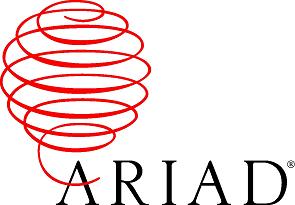in caricamento ...
ASCO 2011… gli abstract (prima parte).
 Ponatinib:
Ponatinib:
Abstract:
Background: Ponatinib is an oral multiple tyrosine kinase inhibitor and potent pan-BCR-ABL inhibitor. Preliminary phase 1 results suggest substantial activity in BCR-ABL+ patients (pts). In preclinical models, ponatinib also inhibits the FLT3/ITD mutant prevalent in AML with potency similar to that of BCR-ABL (IC50 2 nM). A cohort of pts with AML was enrolled in a phase 1 trial of ponatinib to assess safety and preliminary efficacy in this population. Methods: Pts (≥18 years) with relapsed or refractory AML were enrolled after the recommended phase 2 dose of ponatinib was established in pts with chronic myeloid leukemia (CML). Pts received 45 mg ponatinib orally once daily: trough plasma concentrations are known to exceed the target for inhibition of FLT3/ITD activity (IC50) in cells at this dose. FLT3/ITD mutation status was determined at a central laboratory. Results: Of 81 total pts in this study, 12 were included in the AML cohort. The median age of AML pts was 49 (range 30-72) years. At the time of analysis (Dec 15, 2010), 4 (33%) AML pts remained on study (range 77-143 days) and 8 (67%) discontinued (range 10-97 days) (no discontinuations were treatment related). Seven AML pts had documented FLT3/ITD at baseline, 2 did not carry FLT3 alterations, and 3 pts had inadequate samples for testing; however, these 3 pts had a positive FLT3 status reported by investigative sites. Overall, 7 pts with the FLT3/ITD mutation were FLT3 inhibitor naïve. All pts had treatment emergent AEs consistent with those expected in refractory AML. Three pts had treatment related grade 2 pancreatitis: 1 pt subsequently discontinued due to investigator decision; 2 had the event resolve and continued therapy at a reduced dose. The overall response rate in the AML cohort was 25% (3/12): 2 pts (29%) had CRi and 1 (14%) had PR. All responses observed were in the subset of pts with the FLT3/ITD mutation who were naïve to FLT3 inhibitors: 3/7 (43%). Conclusions: Ponatinib was well‑tolerated in this small group of AML patients; the safety profile was similar to that observed in CML. Evidence of activity in pts with the FLT3/ITD mutation was observed, with a response rate of 43% (3/7) in FLT3 inhibitor naïve pts.
CTIC mi lascia con l’amaro in bocca… Tosedostat:
Abstract:
Background: Tosedostat is a novel oral aminopeptidase inhibitor which has shown promising efficacy in elderly relapsed/refractory AML (Lowenberg 2010). OPAL will provide additional data from a more tightly defined patient population and explore different dosing regimens. Methods: OPAL is a single-arm study of 73 AML patients aged >60 years who had a previous CR lasting less than 12 months, or no CR (Estey 1996) after primary induction. Patients received oral tosedostat, either 120 mg once daily for 6 months, or 240 mg once daily for 2 months followed by 120 mg once daily for 4 months. The pre-specified interim analysis at 3 months was based on bone marrow responses (complete <5% blasts, partial 5 to 25% blasts). Results: There were 15 responders (21%); 8 (21%) in the 120 mg arm, and 7 (20%) in the 240 mg arm. 22 patients (31%) had a best response of stable disease. There were 23 (32%) unevaluable patients (no month 1 bone marrow). Tosedostat was generally well tolerated by patients. Conclusions: The data is in line with the previous study and provides further encouraging data. Final analysis of the study will take place at 6 months. Plans for a phase III program with tosedostat in AML are well advanced.
Opaxio in pazienti con glioma (per NSCLC sapevamo che sarebbe stato un insuccesso…):
Abstract:
Background: PPX is a drug conjugate that links paclitaxel to a polyglutamic acid polymer yielding a radiosensitization index of 4-8 as compared to 1.5-2 for paclitaxel. Phase I/II studies of PPX in esophageal cancer established that 50 mg/m2/week of PPX can be safely administered with concurrent chemo/RT. The primary objective of this study is to determine the safety of PPX with standard TMZ and RT for high-grade gliomas. Methods: Patients received weekly PPX 50 mg/ m2 and daily TMZ 75 mg/m2 for 6 weeks with concomitant RT (60 Gy). Adjuvant chemotherapy with TMZ (200 mg/m2/d x 5 d), every 28 days, was started 1 month after completion of chemoradiation. Results: This study completed planned accrual of 25 patients (median age, 60 years; 48% male; 60% GBMs). Grade 4 hematologic toxicity occurred in 6 of 25 patients, starting 4-6 weeks after initiating PPX/TMZ/RT and lasting up to 5 months. Median follow-up is 13 months (range, 1-24). 6- and 12- month PFS were 76% (19/25 patients) and 52% (13/25). The 6-month PFS of GBM patients was 66.7% (10/15). Median PFS is 12.5 months. Pseudoprogression (PsdP) was prominent. 16 patients had post-PPX enhancement, 5 were classified with progressive disease (mean time to progression = 4.6 months; rCBV at progression ranged from 2.66 to 6.25, mean = 4.1) and 11 remain on trial. For cases of PsdP, rCBV at time of initial progressive enhancement ranged from 0.63 to 5.28 (mean 2.55), but subsequently stabilized or monotonically decreased, with no statistically significant increased rCBV compared with initial post-PPX baseline. rCBV in progressive disease was not found to be significantly larger than rCBV at initial progressive enhancement in PsdP (p=0.16, unpaired t-test). 5 patients with apparent progression by MRI had resection (2) or biopsy (3). Pathologic specimens showed gliotic edematous brain and all had Ki-67 < 5%. Conclusions: PPX is a promising radiation enhancer in high grade gliomas. Stable or decreasing rCBV on longitudinal follow-up exams may be a better indicator of PsdP than individual absolute rCBV values. Hematologic toxicity may be due to interaction between PPX and TMZ. A randomized study of PPX/RT versus TMZ/RT for with non-methylated MGMTpatients is planned.
I am very interested about it, will you share more detail? Like source of this story?
Devi essere connesso per inviare un commento.




Interesting, still I’ve came accross one completely opposite blog post the other day